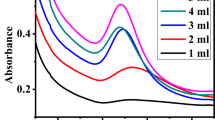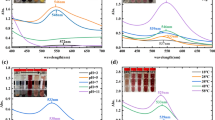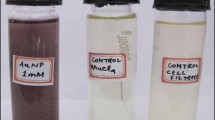Abstract
Microbial synthesis of gold nanoparticles (GNPs) has attracted considerable attention in recent times due to their exceptional capability for the bioremediation of industrial wastes and also for the treatment of wastewater. A bacterial strain Staphylococcus warneri, isolated from the estuarine mangroves of Sundarbans region produced highly stable GNPs by reducing hydrogen auric chloride (HAucl4) salt using intracellular protein extract. The nanoparticles were characterized utilizing ultraviolet-visible spectrophotometry, transmission electron microscopy, scanning electron microscopy, atomic force microscopy, X-ray diffraction, and surface enhanced Raman scattering. Highly dispersed, spherically shaped GNPs varied around 15–25 nm in size and were highly crystalline with face-centered cubic structures. Recyclable catalytic activity of as-synthesized GNPs was evidenced by complete degradation of nitro aromatic pollutants like 2-nitroaniline, 4-nitroaniline, 2-nitrophenol and 4-nitrophenol. Our GNPs show excellent and efficient catalytic activity with significantly high rate constant (10−1 order) and high turnover frequency (103 order) in recyclable manner up to three times. To our knowledge, this is the first report of Staphylococcus warneri in the production of gold nanoparticles. This green technology for bioremediation of toxic nitro aromatic pollutants is safe and economically beneficial to challenge the development and sustainability issue.











Similar content being viewed by others
References
Altschul SF, Gish W, Miller W et al (1990) Basic local alignment search tool. J Mol Biol 215:403–410. https://doi.org/10.1016/S0022-2836(05)80360-2
Anantharaj S, Jayachandran M, Kundu S (2016) Unprotected and interconnected Ru 0 nano-chain networks: advantages of unprotected surfaces in catalysis and electrocatalysis. Chem Sci 7:3188–3205. https://doi.org/10.1039/C5SC04714E
Bai X, Gao Y, Liu H, Zheng L (2009) Synthesis of amphiphilic ionic liquids terminated gold nanorods and their superior catalytic activity for the reduction of nitro compounds. J Phys Chem C 113:17730–17736. https://doi.org/10.1021/jp906378d
Balasubramanian SK, Yang L, Yung L-YL et al (2010) Characterization, purification, and stability of gold nanoparticles. Biomaterials 31:9023–9030. https://doi.org/10.1016/j.biomaterials.2010.08.012
Biju V (2014) Chemical modifications and bioconjugate reactions of nanomaterials for sensing, imaging, drug delivery and therapy. Chem Soc Rev 43:744–764. https://doi.org/10.1039/C3CS60273G
Binupriya AR, Sathishkumar M, Vijayaraghavan K, Yun S-I (2010) Bioreduction of trivalent aurum to nano-crystalline gold particles by active and inactive cells and cell-free extract of Aspergillus oryzae var. viridis. J Hazard Mater 177:539–545. https://doi.org/10.1016/j.jhazmat.2009.12.066
Boone DR, Castenholz RW, Garrity GM (eds) (2001) Bergey’s manual of systematic bacteriology, 2nd edn. New York, Springer
Booth G (2000) Nitro compounds, aromatic. In: Wiley-VCH Verlag GmbH &Co. KGaA (ed) Ullmann’s encyclopedia of industrial chemistry. Wiley-VCH Verlag GmbH &Co. KGaA, Weinheim, Germany
Chakraborty A, Bera A, Mukherjee A et al (2015) Changing bacterial profile of Sundarbans, the world heritage mangrove: impact of anthropogenic interventions. World J Microbiol Biotechnol 31:593–610. https://doi.org/10.1007/s11274-015-1814-5
Chirea M, Freitas A, Vasile BS et al (2011) Gold nanowire networks: synthesis, characterization, and catalytic activity. Langmuir 27:3906–3913. https://doi.org/10.1021/la104092b
Chiu C-Y, Chung P-J, Lao K-U et al (2012) Facet-dependent catalytic activity of gold nanocubes, octahedra, and rhombic dodecahedra toward 4-nitroaniline reduction. J Phys Chem C 116:23757–23763. https://doi.org/10.1021/jp307768h
Correa-Llantén DN, Muñoz-Ibacache SA, Castro ME et al (2013) Gold nanoparticles synthesized by Geobacillus sp. strain ID17 a thermophilic bacterium isolated from Deception Island, Antarctica. Microb Cell Fact 12:75. https://doi.org/10.1186/1475–2859–12-75
Dahl JA, Maddux BLS, Hutchison JE (2007) Toward greener nanosynthesis. Chem Rev 107:2228–2269. https://doi.org/10.1021/cr050943k
Das SK, Dickinson C, Lafir F et al (2012) Synthesis, characterization and catalytic activity of gold nanoparticles biosynthesized with Rhizopus oryzae protein extract. Green Chem 14:1322. https://doi.org/10.1039/c2gc16676c
Dash SS, Bag BG (2014) Synthesis of gold nanoparticles using renewable Punica granatum juice and study of its catalytic activity. Appl Nanosci 4:55–59. https://doi.org/10.1007/s13204-012-0179-4
Esumi K, Isono R, Yoshimura T (2004) Preparation of PAMAM– and PPI–metal (silver, platinum, and palladium) nanocomposites and their catalytic activities for reduction of 4-nitrophenol. Langmuir 20:237–243. https://doi.org/10.1021/la035440t
Fan G-Y, Huang W-J (2014) Synthesis of ruthenium/reduced graphene oxide composites and application for the selective hydrogenation of halonitroaromatics. Chin Chem Lett 25:359–363. https://doi.org/10.1016/j.cclet.2013.11.044
Fu A, Zhang E (2015) A new strategy for specific imaging of neural cells based on peptide-conjugated gold nanoclusters. Int J Nanomed 2115. doi: https://doi.org/10.2147/IJN.S78554
Gangula A, Podila R, Rao M et al (2011) Catalytic reduction of 4-nitrophenol using biogenic gold and silver nanoparticles derived from Breynia rhamnoides. Langmuir 27:15268–15274. https://doi.org/10.1021/la2034559
Gole A, Dash C, Ramakrishnan V et al (2001) Pepsin–gold colloid conjugates: preparation, characterization, and enzymatic activity. Langmuir 17:1674–1679. https://doi.org/10.1021/la001164w
Guria MK, Majumdar M, Bhattacharyya M (2016) Green synthesis of protein capped nano-gold particle: an excellent recyclable nano-catalyst for the reduction of nitro-aromatic pollutants at higher concentration. J Mol Liq 222:549–557. https://doi.org/10.1016/j.molliq.2016.07.087
He S, Guo Z, Zhang Y et al (2007) Biosynthesis of gold nanoparticles using the bacteria Rhodopseudomonas capsulata. Mater Lett 61:3984–3987. https://doi.org/10.1016/j.matlet.2007.01.018
Hulkoti NI, Taranath TC (2014) Biosynthesis of nanoparticles using microbes—a review. Colloids Surf B Biointerfaces 121:474–483. https://doi.org/10.1016/j.colsurfb.2014.05.027
Iravani S (2014) Bacteria in nanoparticle synthesis: current status and future prospects. Int Sch Res Notices 2014:1–18. https://doi.org/10.1155/2014/359316
Jia H, Gao X, Chen Z et al (2012) The high yield synthesis and characterization of gold nanoparticles with superior stability and their catalytic activity. Cryst Eng Comm 14:7600. https://doi.org/10.1039/c2ce25840d
Jiang H, Dong H, Zhang G et al (2006) Microbial diversity in water and sediment of Lake Chaka, an Athalassohaline Lake in northwestern China. Appl Environ Microbiol 72:3832–3845. https://doi.org/10.1128/AEM.02869-05
Kannan P, Abraham John S (2008) Synthesis of mercaptothiadiazole-functionalized gold nanoparticles and their self-assembly on Au substrates. Nanotechnology 19:85602. https://doi.org/10.1088/0957-4484/19/8/085602
Karthick V, Kumar VG, Dhas TS et al (2014) Effect of biologically synthesized gold nanoparticles on alloxan-induced diabetic rats—an in vivo approach. Colloids Surf B Biointerfaces 122:505–511. https://doi.org/10.1016/j.colsurfb.2014.07.022
Kim BK, Lim Y-W, Kim M et al (2007) EzTaxon: a web-based tool for the identification of prokaryotes based on 16S ribosomal RNA gene sequences. Int J Syst Evol Microbiol 57:2259–2261. https://doi.org/10.1099/ijs.0.64915-0
Kim JH, Park JH, Chung YK, Park KH (2012) Ruthenium nanoparticle-catalyzed, controlled and Chemoselective hydrogenation of nitroarenes using ethanol as a hydrogen source. Adv Synth Catal 354:2412–2418. https://doi.org/10.1002/adsc.201200356
Lee J, Park JC, Bang JU, Song H (2008) Precise tuning of porosity and surface functionality in Au@SiO 2 nanoreactors for high catalytic efficiency. Chem Mater 20:5839–5844. https://doi.org/10.1021/cm801149w
Li H, Gao S, Zheng Z, Cao R (2011) Bifunctional composite prepared using layer-by-layer assembly of polyelectrolyte–gold nanoparticle films on Fe3O4–silica core–shell microspheres. Catal Sci Technol 1:1194. https://doi.org/10.1039/c1cy00096a
Lin C, Tao K, Hua D et al (2013) Size effect of gold nanoparticles in catalytic reduction of p-nitrophenol with NaBH4. Molecules 18:12609–12620. https://doi.org/10.3390/molecules181012609
Lin W-H, Lu Y-H, Hsu Y-J (2014) Au nanoplates as robust, recyclable SERS substrates for ultrasensitive chemical sensing. J Colloid Interface Sci 418:87–94. https://doi.org/10.1016/j.jcis.2013.11.082
Liu H, Yang Q (2011) Facile fabrication of nanoporous Au–Pd bimetallic foams with high catalytic activity for 2-nitrophenol reduction and SERS property. J Mater Chem 21:11961. https://doi.org/10.1039/c1jm10109a
Mandlimath TR, Gopal B (2011) Catalytic activity of first row transition metal oxides in the conversion of p-nitrophenol to p-aminophenol. J Mol Catal A Chem 350:9–15. https://doi.org/10.1016/j.molcata.2011.08.009
Manivasagan P, Alam MS, Kang K-H et al (2015) Extracellular synthesis of gold bionanoparticles by Nocardiopsis sp. and evaluation of its antimicrobial, antioxidant and cytotoxic activities. Bioprocess Biosyst Eng 38:1167–1177. https://doi.org/10.1007/s00449-015-1358-y
Meena Kumari M, Jacob J, Philip D (2015) Green synthesis and applications of Au–Ag bimetallic nanoparticles. Spectrochim Acta A Mol Biomol Spectrosc 137:185–192. https://doi.org/10.1016/j.saa.2014.08.079
Mohanpuria P, Rana NK, Yadav SK (2008) Biosynthesis of nanoparticles: technological concepts and future applications. J Nanopart Res 10:507–517. https://doi.org/10.1007/s11051-007-9275-x
Nangia Y, Wangoo N, Goyal N et al (2009) A novel bacterial isolate Stenotrophomonas maltophilia as living factory for synthesis of gold nanoparticles. Microb Cell Factories 8:39. https://doi.org/10.1186/1475-2859-8-39
Narayanan KB, Sakthivel N (2010) Biological synthesis of metal nanoparticles by microbes. Adv Colloid Interf Sci 156:1–13. https://doi.org/10.1016/j.cis.2010.02.001
Narayanan KB, Sakthivel N (2011) Synthesis and characterization of nano-gold composite using Cylindrocladium floridanum and its heterogeneous catalysis in the degradation of 4-nitrophenol. J Hazard Mater 189:519–525. https://doi.org/10.1016/j.jhazmat.2011.02.069
Narayanan R, El-Sayed MA (2004) Shape-dependent catalytic activity of platinum nanoparticles in colloidal solution. Nano Lett 4:1343–1348. https://doi.org/10.1021/nl0495256
Patra S, Mukherjee S, Barui AK et al (2015) Green synthesis, characterization of gold and silver nanoparticles and their potential application for cancer therapeutics. Mater Sci Eng C 53:298–309. https://doi.org/10.1016/j.msec.2015.04.048
Pu Y-C, Wang G, Chang K-D et al (2013) Au nanostructure-decorated TiO2 nanowires exhibiting photoactivity across entire UV-visible region for photoelectrochemical water splitting. Nano Lett 13:3817–3823. https://doi.org/10.1021/nl4018385
Rajan A, MeenaKumari M, Philip D (2014) Shape tailored green synthesis and catalytic properties of gold nanocrystals. Spectrochim Acta A Mol Biomol Spectrosc 118:793–799. https://doi.org/10.1016/j.saa.2013.09.086
Reddy V, Torati RS, Oh S, Kim C (2013) Biosynthesis of gold nanoparticles assisted by Sapindus mukorossi Gaertn. Fruit pericarp and their catalytic application for the reduction of p-nitroaniline. Ind Eng Chem Res 52:556–564. https://doi.org/10.1021/ie302037c
Sana B, Ghosh D, Saha M, Mukherjee J (2007) Purification and characterization of an extremely dimethylsulfoxide tolerant esterase from a salt-tolerant Bacillus species isolated from the marine environment of the Sundarbans. Process Biochem 42:1571–1578. https://doi.org/10.1016/j.procbio.2007.05.026
Sengupta S, Pramanik A, Ghosh A, Bhattacharyya M (2015) Antimicrobial activities of actinomycetes isolated from unexplored regions of Sundarbans mangrove ecosystem. BMC Microbiol 15:170. https://doi.org/10.1186/s12866-015-0495-4
Shankar SS, Rai A, Ankamwar B et al (2004) Biological synthesis of triangular gold nanoprisms. Nat Mater 3:482–488. https://doi.org/10.1038/nmat1152
Sharma N, Pinnaka AK, Raje M et al (2012) Exploitation of marine bacteria for production of gold nanoparticles. Microb Cell Factories 11:86. https://doi.org/10.1186/1475-2859-11-86
Sharma S (2015) Metal dependent catalytic hydrogenation of nitroarenes over water-soluble glutathione capped metal nanoparticles. J Colloid Interface Sci 441:25–29. https://doi.org/10.1016/j.jcis.2014.11.030
Shen W, Qu Y, Pei X et al (2016) Green synthesis of gold nanoparticles by a newly isolated strain Trichosporon montevideense for catalytic hydrogenation of nitroaromatics. Biotechnol Lett 38:1503–1508. https://doi.org/10.1007/s10529-016-2120-5
Shi C, Zhu N, Cao Y, Wu P (2015) Biosynthesis of gold nanoparticles assisted by the intracellular protein extract of Pycnoporus sanguineus and its catalysis in degradation of 4-nitroaniline. Nanoscale Res Lett 10:147. https://doi.org/10.1186/s11671-015-0856-9
Singh C, Goyal A, Singhal S (2014) Nickel-doped cobalt ferrite nanoparticles: efficient catalysts for the reduction of nitroaromatic compounds and photo-oxidative degradation of toxic dyes. Nano 6:7959. https://doi.org/10.1039/c4nr01730g
Singha SS, Nandi D, Singha A (2015) Tuning the photoluminescence and ultrasensitive trace detection properties of few-layer MoS2 by decoration with gold nanoparticles. RSC Adv 5:24188–24193. https://doi.org/10.1039/C5RA01439E
Sperling RA, Rivera Gil P, Zhang F et al (2008) Biological applications of gold nanoparticles. Chem Soc Rev 37:1896. https://doi.org/10.1039/b712170a
Srivastava SK, Yamada R, Ogino C, Kondo A (2013) Biogenic synthesis and characterization of gold nanoparticles by Escherichia coli K12 and its heterogeneous catalysis in degradation of 4-nitrophenol. Nanoscale Res Lett 8:70. https://doi.org/10.1186/1556-276X-8-70
Stalin Dhas T, Ganesh Kumar V, Stanley Abraham L et al (2012) Sargassum myriocystum mediated biosynthesis of gold nanoparticles. Spectrochim Acta A Mol Biomol Spectrosc 99:97–101. https://doi.org/10.1016/j.saa.2012.09.024
Tamura K, Stecher G, Peterson D et al (2013) MEGA6: Molecular Evolutionary Genetics Analysis version 6.0. Mol Biol Evol 30:2725–2729. https://doi.org/10.1093/molbev/mst197
Tan L, Chen D, Liu H, Tang F (2010) A silica nanorattle with a mesoporous shell: an ideal nanoreactor for the preparation of tunable gold cores. Adv Mater 22:4885–4889. https://doi.org/10.1002/adma.201002277
Uma Suganya KS, Govindaraju K, Ganesh Kumar V et al (2015) Blue green alga mediated synthesis of gold nanoparticles and its antibacterial efficacy against Gram positive organisms. Mater Sci Eng C 47:351–356. https://doi.org/10.1016/j.msec.2014.11.043
Vinay Gopal J, Thenmozhi M, Kannabiran K et al (2013) Actinobacteria mediated synthesis of gold nanoparticles using Streptomyces sp. VITDDK3 and its antifungal activity. Mater Lett 93:360–362. https://doi.org/10.1016/j.matlet.2012.11.125
Weir RJ, Fisher RS (1972) Toxicologic studies on borax and boric acid. Toxicol Appl Pharmacol 23:351–364
Wu C-C, Chen D-H (2012) Spontaneous synthesis of gold nanoparticles on gum arabic-modified iron oxide nanoparticles as a magnetically recoverable nanocatalyst. Nanoscale Res Lett 7:317. https://doi.org/10.1186/1556-276X-7-317
Wu X-Q, Wu X-W, Huang Q et al (2015) In situ synthesized gold nanoparticles in hydrogels for catalytic reduction of nitroaromatic compounds. Appl Surf Sci 331:210–218. https://doi.org/10.1016/j.apsusc.2015.01.077
Wunder S, Polzer F, Lu Y et al (2010) Kinetic analysis of catalytic reduction of 4-nitrophenol by metallic nanoparticles immobilized in spherical polyelectrolyte brushes. J Phys Chem C 114:8814–8820. https://doi.org/10.1021/jp101125j
Zhan G, Huang J, Du M et al (2012) Liquid phase oxidation of benzyl alcohol to benzaldehyde with novel uncalcined bioreduction Au catalysts: high activity and durability. Chem Eng J 187:232–238. https://doi.org/10.1016/j.cej.2012.01.051
Zhu C-H, Hai Z-B, Cui C-H et al (2012) In situ controlled synthesis of thermosensitive poly(N-isopropylacrylamide)/au nanocomposite hydrogels by gamma radiation for catalytic application. Small 8:930–936. https://doi.org/10.1002/smll.201102060
Acknowledgements
We acknowledge the World Bank, for all the necessary support for the execution of ICZM project, West Bengal. Sudip Nag acknowledges World Bank ICZM project (54-ICZMP/3P) for providing his fellowship and financial support to carry out this work. Dr. Arnab Pramanik is supported by Research Associateship from NCSCM (MoEF, Govt. of India, grant no. 21/RCO/CR/CMR/2013). We would like to acknowledge the continuous encouragement and enthusiasm expressed by Mr. Tapas Paul and Dr. Herbert K. Acquay from the World Bank in our venture to explore the world heritage site, Sundarbans. We express our sincere gratitude to SPMU, NPMU, and IESWM for their continuous support. We are grateful to Prof. Parimal Karmakar, Jadavpur University, for his support during DLS and zeta potential measurements; Dr. Dipankar Das and Mr. Pallippuram Venkitaraman Rajesh, UGC-DAE, for their help in using XRD facility; Prof. Munna Sarkar, Saha Institute of Nuclear Physics, for her support during FTIR data analysis; and Dr. Subrata Kundu, CSIR-Central Electrochemical Research Institute for the valuable discussion. We are grateful to Dr. Achintya Singha and Mr. Tara Shankar Bhattacharya, Bose Institute, for their active support in performing SERS measurement and analyzing the data. We like to acknowledge UGC-CAS, DST–FIST, DBT-IPLS, UGC-UPE in the Department of Biochemistry, University of Calcutta, and Centre for Research in Nanoscience and Nanotechnology (CRNN), University of Calcutta, for providing the instrumental facility and infrastructural support. It would not be possible to carry out this work without the help and support of the local people of the Sundarbans. We express our inability to acknowledge them individually.
Author information
Authors and Affiliations
Corresponding author
Ethics declarations
Conflict of interest
The authors declare that they have no conflict of interest.
Ethical statement
This article does not contain any studies with human participants or animals performed by any of the authors.
Additional information
Responsible editor: Santiago V. Luis
Electronic supplementary material
ESM 1
(DOCX 4982 kb)
Rights and permissions
About this article
Cite this article
Nag, S., Pramanik, A., Chattopadhyay, D. et al. Green-fabrication of gold nanomaterials using Staphylococcus warneri from Sundarbans estuary: an effective recyclable nanocatalyst for degrading nitro aromatic pollutants. Environ Sci Pollut Res 25, 2331–2349 (2018). https://doi.org/10.1007/s11356-017-0617-7
Received:
Accepted:
Published:
Issue Date:
DOI: https://doi.org/10.1007/s11356-017-0617-7




